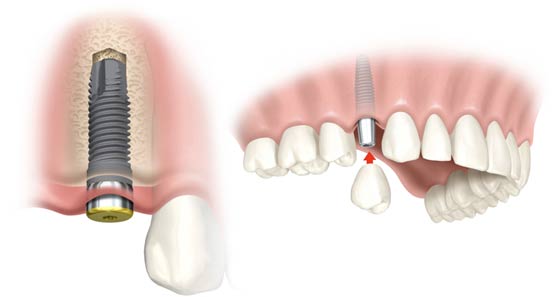
In today’s world millions of people are unfortunate enough to experience tooth loss. The causes can be attributed to a variety of reasons such as gum disease, tooth decay, injury and more. The only way to treat tooth loss in previous years was with the use of bridges and dentures. Today, when you experience tooth loss, the option of having dental implants is available.
What is a Dental Implant?
Due to modern advances in dentistry, a properly trained dental specialist can implant a device made of titanium directly into the jawbone, also known as a root device. This device will support a tooth or group of restorative teeth, which will be substitutes for missing teeth. In many respects they function in an identical fashion to actual teeth.
History of dental implants
The practice of providing dental implants to those who experience tooth loss has been around for several decades. In 1952 Dr. Leonard Linkow used the first dental implants on a patient, a few months after graduating from dental school. Forty years later, in 1992 Dr. Linkow had placed over 19,000 dental implants in patients. Today implant dentists call Dr. Linkow the ‘father of modern implant dentistry’.
Health requirements
Those healthy enough to receive oral surgery or endure dental extraction should be suitable for the dental implant procedure. Patients, who are heavy smokers or suffer from a chronic disorder such as heart disease or diabetes, will have to be thoroughly evaluated beforehand. Furthermore, patients who have undergone any type of recent radiation therapy to their head or neck areas will also have to undergo evaluation.
Dental Implants and Dental Insurance
As a general rule dental implants are not covered by dental insurance policies. However, coverage for the procedure under a person’s medical plan may be possible. A dentist or a person’s insurance provider can usually answer such questions.
First step toward Dental Implants
When a patient requests dental implants one of the first steps is for their dentist to develop a treatment plan dependent on the individual’s dental needs. Dental professionals who have the necessary training and experience in restorative dentistry and oral surgery create the plan. They work together as a team to meet the patient’s dental implant requirements and make them aware of further options regarding materials used for example.
The Dental Implant Procedure
A small post of titanium is surgically placed into the bone socket, where there is a missing tooth. When the procedure has been completed, the jawbone will begin the healing process and grow around the implanted titanium post. This will help anchor the post firmly to the jaw. The process of healing will usually take between six to 12 weeks.
Final Step
After the implant has attached itself to the jawbone an abutment or connector post, which will hold the new tooth, is attached. Impressions of the patient’s original teeth will be used to create the replacement teeth. The replacement teeth are called crowns from a dental crown laboratory and are firmly attached to the abutment. Some patients choose to have attachments placed on their implants, which are designed for the use of a removable denture.
The Results
The replacement teeth are made to look, feel and function as if they were a patient’s own, natural teeth. Dental implants like all on 4 dental implants are very well known for their durability. With proper care and maintenance dental implants have been proven to last a lifetime.

Happy to read something about”Dental Implants”. Thanks
Dental Implants Brooklyn